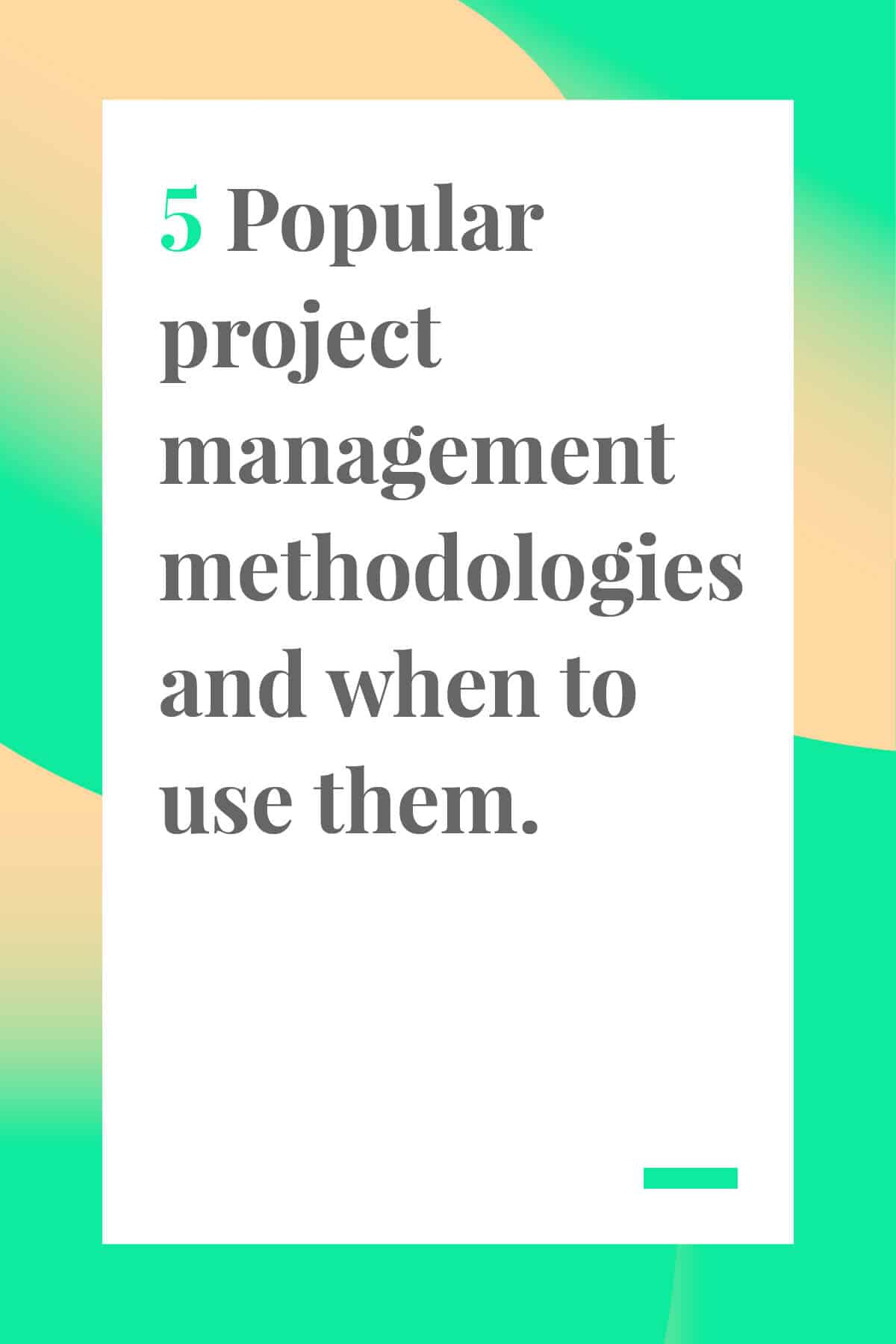With all the project management methodologies out there, how do you pick the right one? As a project manager, you know that selecting the correct methodology is an essential part of getting the project done correctly and on time. These processes provide you with guidance and a series of predefined steps that lead to task completion, but each one has its own set of rules, principles, and practices that enable progress and manage complications that may arise during project delivery.
So which one should you choose? It depends on your project scope, your project management tool and requirements: there is no such thing as a ‘right’ methodology for all situations. While there are different processes available (Six Sigma, Kanban, and Lean are popular examples), not all of them are a perfect fit for every project. Below is a list of 5 popular project methodologies and when they should be used for maximum efficacy.

1. Agile
Agile project management is well-named. It values individual interactions over impersonal processes and tools, so one of its core strengths is its ability to adapt to changing situations and ongoing feedback results. It uses iterative and incremental work sequences that are referred to as ‘sprints.’
When members of your team collaborate closely with upper management and clients, directions and solutions tend to evolve and change recognition is important. The Agile methodology is adaptable and flexible enough to allow for these face-to-face interactions and collaborative practices without sending the project off-track or even worse, stalling it completely.
Best suited for: Projects that involve a certain amount of uncertainty and complexity, such as software development. More emphasis tends to be on continuous improvement in the name of high-quality results and obtaining a competitive advantage for the client. IBM is one company that openly uses the Agile methodology to develop its software.
2. Kanban
Although Kanban is technically an Agile framework, it is widely regarded as its own methodology. Originally developed to improve Toyota factory production lines during the 1940s, Kanban is a visual process that paints a picture of the project workflow system so that bottlenecks and similar problems can be detected during the early stages of product development.
Kanban visual cues are:
- A Kanban board that can be physical (such as a whiteboard drawing or carefully arranged sticky notes) or digital, like charts produced by web-based project management tools such as Trello. Its basic layout is three columns marked ‘ To Do’, ‘In Progress’ and ‘Done.’
- Kanban cards that each depict a task in the work process. They are used to visually convey information such as project status, upcoming deadlines, and overall progress.
- Kanban swimlanes that provide a good overview of the project workflow by categorizing tasks and deliverable and laying them out horizontally.
Best suited for: Software development and any other project that emphasizes continuous improvements in the development process. Many people also use it for personal productivity action plans.

3. Lean
The lean methodology aims to maximize customer value by using fewer resources, which minimized waste. Like Agile, it is a concept that evolved from the Japanese manufacturing industry, which emphasizes the elimination of waste as a method of improving quality and reducing both costs and production time.
Lean project management recognizes three types of waste, commonly known as the 3Ms:
- Muda: Eliminating a process or activity that does not add value to the project. It can refer to a physical waste, such as raw materials and inventory, or a waste of resources, such as over-processing and overproduction.
- Mura: Trimming away workflow process delays that could affect scheduling and operations. Examples include a worker spending too much time perfecting a design, giving team members at the next stage in the timeline less time to do their work.
- Muri: Getting rid of excess baggage so that the process does not slow down. It refers mainly to project managers who slow their team members down via poor organization, micromanaging, and other time-wasting practices.
Best suited for: Companies that want to change the way that they do business. As a methodology, it addresses more operational than project processes.
4. Waterfall
One of the best-known and more traditional project management methodologies, Waterfall takes a sequential and linear design approach in which progress ‘flows’ downwards, in a single fluid direction, like a waterfall. It originally appeared in the construction and manufacturing industry, where plans are rigidly structured and change and experimentation cost money. The premise of the waterfall methodology is that the team can only move to the next stage in the project timeline after the present phase has been successfully completed. The phases are:
- System and software requirements
- Analysis
- Design
- Coding
- Testing
- Operations
Best suited for: Bigger projects, such as public infrastructure, that require the team to maintain strict deadlines and move from one stage only after the previous one has been completed. Before Agile appeared, the Waterfall methodology was used to develop software, but it was later found to be too non-adaptive and not conducive to customer feedback.

5. Six Sigma
Originally introduced by Motorola engineers during the mid-1980s, Six Sigma strives to improve project quality and success by identifying what is not working and removing it from the process. Its main resources are quality management tools that rely on statistical and empirical data as well as expert input, to reduce the number of errors.
Six Sigma has two primary methodologies:
- DMAIC, an acronym for defining the problem and project goals, measuring the aspects of the process currently being used, analyzing data to detect core defects, improving the process, and controlling how it is carried out in the future.
- DMADV, an acronym for defining the project goals, measuring the essential parts of the process and product, analyzing the data to develop various process designs and choose the best one, designing and testing the new process and verifying its quality via simulations and other testing
Best suited for: Bigger organizations and companies that want to use data to improve their operating efficiency and output quality.
Choosing the right methodology for your project is critical to its success. When you find one that meets the needs of the project, industry, and / or organization your team will have the blueprint it needs to deliver quality results.
Rose Keefe is an author and technical writer who has over ten years’ experience in supporting project managers in the manufacturing and construction sectors. One of her primary responsibilities was developing product manuals that supported efficient use of industrial equipment. She continues to write on the subject of time management and commercial productivity for trade websites and publications.

